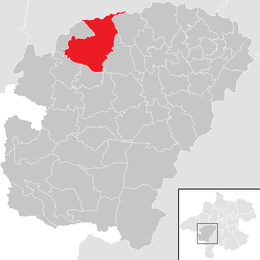Frankenburg am Hausruck
Frankenburg am Hausruck is a municipality in the district of Vöcklabruck in the Austrian state of Upper Austria.
Frankenburg am Hausruck | |
|---|---|
 Coat of arms | |
 Location in the district | |
 Frankenburg am Hausruck Location within Austria | |
| Coordinates: 48°04′06″N 13°29′31″E | |
| Country | Austria |
| State | Upper Austria |
| District | Vöcklabruck |
| Government | |
| • Mayor | Heinz Leprich (SPÖ) |
| Area | |
| • Total | 48.55 km2 (18.75 sq mi) |
| Elevation | 519 m (1,703 ft) |
| Population (2018-01-01)[2] | |
| • Total | 4,842 |
| • Density | 100/km2 (260/sq mi) |
| Time zone | UTC+1 (CET) |
| • Summer (DST) | UTC+2 (CEST) |
| Postal code | 4873 |
| Area code | 07683 |
| Vehicle registration | VB |
| Website | www.frankenburg.info |
History
The town is known as the site of an incident known as the Frankenburger Würfelspiel (Frankenburg Dice Game). In 1625, during the Counter-Reformation, Lutheran peasants revolted against the attempt by the local landowner, Count Herberstorff, to impose a Catholic priest on the town. Despite his promise of amnesty, The Count had the town leaders arrested, divided them into groups of two, and forced each pair to gamble with dice for their lives. Thirty-six men were hanged. This act triggered the Upper Austrian peasants' revolt of 1626. The revolt was defeated and Catholicism was reimposed. In remembrance of the event, a festival has been held every other year since 1925, including performances at what is claimed to be the largest open-air theatre in Europe.[3]
In 1936 the incident was the subject of a play, Frankenburger Würfelspiel, by the German dramatist Eberhard Wolfgang Möller. The play was commissioned by the German Propaganda Minister, Joseph Goebbels, for the opening of the Dietrich-Eckart-Bühne, an outdoor theatre (Thingplatz) near the Berlin Olympic Stadium (now called the Waldbühne). Goebbels was closely involved in the writing and staging of the play. The anti-Austrian and anti-Catholic aspects of the Frankenburg incident were exploited in the play to serve the Nazi regime's nationalist propaganda aims.
The play was denounced by the Austrian government and banned in Austria. After the Anschluss of 1938, the play was triumphantly staged by the Nazi authorities at Frankenburg and other places in Austria. Speeches were delivered at Frankenburg by Austrian Nazis proclaiming that Adolf Hitler (who was born not far away at Braunau-am-Inn) had avenged the Frankenburg peasants and delivered Austria from the "chains" of the Catholic Church.[4]
Population
| Year | Pop. | ±% |
|---|---|---|
| 1991 | 5,013 | — |
| 2001 | 5,110 | +1.9% |
| 2006 | 5,190 | +1.6% |
| 2014 | 4,818 | −7.2% |
International relations
Sister cities:
.svg.png)
References
- "Dauersiedlungsraum der Gemeinden Politischen Bezirke und Bundesländer - Gebietsstand 1.1.2018". Statistics Austria. Retrieved 10 March 2019.
- "Einwohnerzahl 1.1.2018 nach Gemeinden mit Status, Gebietsstand 1.1.2018". Statistics Austria. Retrieved 9 March 2019.
- "Archived copy". Archived from the original on 2014-03-10. Retrieved 2012-04-08.CS1 maint: archived copy as title (link)
- Gerwin Strobl, The Swastika and the Stage: German Theatre and Society 1933–45, Cambridge 2007, 66–70, gives a detailed account of the play and its historical background.
| Wikimedia Commons has media related to Frankenburg am Hausruck. |